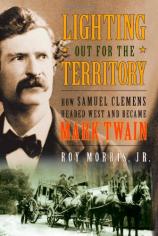Lighting Out for the Territory: How Samuel Clemens Headed West and Became Mark Twain
Review
Lighting Out for the Territory: How Samuel Clemens Headed West and Became Mark Twain
The life and writings of Mark Twain are now very much a part of
American literary and cultural history. No other native-born writer
spoke with precisely his brand of down-home folksiness and cracker
barrel wisdom. Tom Sawyer and Huck Finn are as alive today as any
characters in American fiction.
We all know too that “Mark Twain” was the pen name
adopted by young Samuel Clemens of Hannibal, Missouri, and that it
was a phrase he picked up from his fellow pilots on Mississippi
River boats in the late 1850s and early 1860s. What many do not
realize, however, is that Clemens/Twain found his literary voice
and his new identity during five-and-a-half years of bumming around
the wild Nevada Territory as newspaperman, prospector, businessman,
barfly, lecturer, travel writer and refugee from
respectability.
Historian Roy Morris, Jr. has taken a look at this period in
Twain’s life and given us an entertaining account of his
serio-comic misadventures. This is not scholarly history, nor is it
a full-bore biography, as Twain’s early life and his
post-Nevada career are barely mentioned. Morris’s focus is
limited, and his touch is light.
The book begins with an account of the two brothers’ epic
stagecoach trek from Saint Joseph, Missouri, to Carson City,
Nevada. It covered 1,400 miles, took 20 days, and is told by Morris
with color and gusto. Once they were settled in the territorial
capital of Carson City, Clemens, realizing that his brother Orion
was an ineffectual bumbler, set about carving out a place for
himself in local society. Newspapering was his choice, and he often
fell back on it when other sources of income seemed
insufficient.
Clemens had tried a number of pen names before settling on Mark
Twain, and we all can be eternally grateful that he did not stick
with W. Epaminondas Adrastus Perkins or Thomas Jefferson Snodgrass.
“Mark Twain” first appeared in a newspaper in the wild
frontier outpost of Virginia City, Nevada, on February 3, 1863, and
has been with us ever since.
Twain built his newspaper career by a simple but effective
strategy: he made things up. Always a lover of hoaxes, he delighted
readers and discomfited competitors by spinning yarns that had
little or no basis in fact. Morris seems to enjoy pointing this out
and warns his readers that many of Twain’s later biographers
swallowed some of his fictions whole.
The most famous, purely literary product of Twain’s
western stay was the great short story “The Jumping Frog of
Calaveras County,” which made him famous in highbrow circles
back east. Twain heard it first in the bar of a grubby mining camp
from a fellow named Ben Coon, jotted the idea down in his notebook
and elaborated it into one of American literature’s small
gems.
But newspaper work was not Twain’s only western
occupation. He also got caught up in the gold rush fever that
brought wagonloads of tenderfoot easterners to Nevada hoping to
strike it rich. Twain had no more luck than most of the others, but
his comic-opera misadventures make enjoyable reading in
Morris’s lighthearted retelling. This is a shortish book,
though it does have a lot of padding --- anecdotes about frontier
characters that have no great relevance to Morris’s main
subject, but that make fun reading anyway. Twain’s life
intersected with those of several famous Americans, including
Brigham Young, Bret Harte, U.S. Grant and Charles Farrar
(“Artemus Ward”) Browne. Twain reported that Young
himself had 72 wives but confided that “ten or eleven”
was all you really needed.
Before returning back east, Twain spent four months in Hawaii,
observing the local customs and making good-natured fun of them as
only he could. So droll were his observations and so enjoyable is
Morris’s account of the time that the reader is genuinely
disappointed when Twain actually returns to the respectably dull
life of the east.
This is history with a light touch. Morris has transplanted much
of his material from Twain’s autobiography and from several
of his other books, notably ROUGHING IT. Even when Twain is
spinning fantasies or exaggerating effects, he is grandly
entertaining, and Morris conveys him to us with deadpan good
humor.
Reviewed by Robert Finn (Robertfinn@aol.com) on December 30, 2010
Lighting Out for the Territory: How Samuel Clemens Headed West and Became Mark Twain
- Publication Date: March 2, 2010
- Genres: History, Nonfiction
- Hardcover: 304 pages
- Publisher: Simon & Schuster
- ISBN-10: 1416598669
- ISBN-13: 9781416598664




